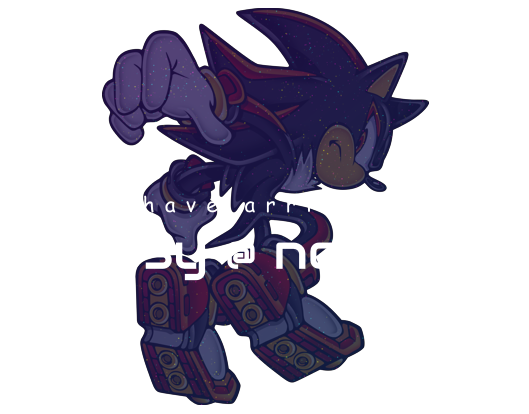music from evangelion
music from evangelion was another music review blog that i ran from december 2012 to may 2013. i covered the entirety of the TV soundtrack of neon genesis evangelion, since i really enjoyed the soundtrack, but there wasn't much love for it on tumblr (besides its iconic intro).
i ran this blog differently than smm; it took no requests and ran daily from january through march. starting in april it posted a couple times a week, and while i started going through the rebuild movie soundtrack, i ended up stopping and considered my mission complete. the commentary style is different too: i took a more formal, objective approach, rather than the "radio host" personality of smm.
archived below is the commentary with links to each music post. i can't host it here (nor would i want to), but it's pretty easy to find if you want to grab it yourself.
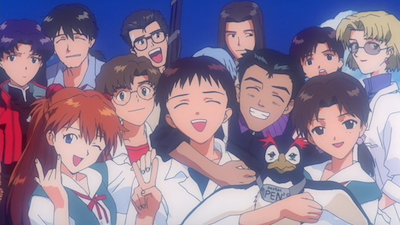
playlist archive
(numbered and listed in soundtrack order)1. Angel Attack
A tense track characterized by dissonant violins, heavy percussion, and a strong low brass section. The low, heavy piano serves as an underlying ostinato that drives the track forward. It drives to a crescendo with help from violins as well as the introduction of electric guitar lines, into a dense chord at the end led by the high trumpets.
2. Rei I
A slow piano piece in A minor. It starts with closed voicings in the high range of the keyboard, then moves on to a more diminished feel. It’s a somber piece that introduces a string section halfway through, adding depth and a ringing sensation to the piece. It continues to build, eventually adding the warmth of a brass section, and ending with a harp cadenza.
3. Hedgehog's Dilemma
A tune reminiscent of a jazz bossa ballad. Using the piano and string sections as driving forces, acoustic guitar is featured as the main comping instrument, introducing thick, arpeggiated chords. The beat is kept with congas in the back of the mix, not overpowering the focus of the tune. The melody sits in the piano, increasing in octaves upon the second time through the form. Again, this track invites a smooth, but melancholy mood.
4. Barefoot in the Park
Another Latin inspired tune, featuring a trumpet melody. The vibraphone provides a smooth comping texture, as well as padding from the string section. The drums resonate in a steady bossa groove, with shakers and auxiliary percussion in the mix as well. The piano takes a back seat while the trumpet melody soars over the wall of sound.
5. Ritsuko
A mid tempo piece featuring acoustic guitar and piano alone. Evocative of the era, the guitar provides a solid bed for the melodic piano. The piece is heavily chord driven, using an abundance of changes to create a melody. With moments of lydian and mixolydian modes, the mood of this track is quietly pleasant.
6. Misato
An up-tempo shuffle piece with a heavy flute feature. The flute rings out sharp and true over the bright drums and strong bass line. The string section provides appropriate kicks, and the bells emphasize the melody, giving it a child like feel. Even when the piano picks up where the flute drops off, it keeps the same, carefree disposition.
7. Asuka Strikes!
An upbeat track with a heavy rockabilly feel. Both the tone of the electric guitar and agression of the violins fit the style of this piece. Bells are also used here, as well as a muted electric piano. The drums stay focused on the snare and cymbal, creating an interesting rhythm. This track has a quirky nature, filled with stops and starts and heavy hits.
8. NERV
A triumphant piece, reminiscent of an earlier era. The swooping violin sounds, combined with the fanfare of trumpets creates high energy, even for a medium tempo piece. The melody in the trombone is an excellent choice, combined with the disco groove in the high-hat. The auxiliary hand percussion adds more color to the mix, as well as an electric piano hidden within the other colors. The trumpet melody is brassy and effective, and even gives the track a bit of a swing.
9. Tokyo-3
A mellow track, featuring both a brass choir and a vocal choir. The vocal choir provides a etheric layer of sound underneath the brass, providing chordal stability. The movement proceeds through the voices, with the tuba as a pedal, then the trombones, then the trumpet on a low fanfare. There is a sense of peace embedded in the color of this track.
10. I. Shinji
An andante funeral march set in F minor. It starts with piano and strings, then gradually expands into an intense crescendo featuring the entire orchestra. The brassy trumpet combined with the tambourine in the background adds distinct color, as well as the height of the violins at the track’s most intense point. The contrast between staccato and legato lines is quite notable.
11. EVA-01
A heroic track that accomplishes the feel without an excessive brass fanfare. Instead, the string section leads, with long falls and tremolos, and a forte melody in the front of the mix. The brass sits back, helping keep the tempo with the marching snare, as well as with padding swells. Harp runs also give this track a majestic color, along with carefully placed cascading trumpet lines, often in the horn’s higher range, and other counterpoint in the trombones.
12. A Step Forward Into Terror
A call to arms, heavily featuring the brass section in fanfare. The drums introduce a rock groove, making this unique from the other heroic themes, not to mention the chords in the trombones giving thick texture. The string section serves to comp in the back, more prominently in the second time through the form. The harp, once again, provides majestic color to the feel, especially at the end of the track. Deep in the mix, there is an electric guitar comping on beats two and four to add to the rock feel.
13. EVA-02
Another powerful piece, featuring the higher trumpet range. Once again, this has a rock drum beat behind it, but takes it a step further by adding a full electric guitar line on top of it for a whole different color to the sound. The strings and horns provide layers of sound, passing the melody back and forth in the shuffle groove. The harp cadenzas are far faster, and the track has an overall confident feel.
14. Decisive Battle
A tight energy piece that fits its name. The addition of the timpani and the harmon muted trumpets provides a new color, and a desperate, tense sound. The tightly controlled horn and trombone kicks are precise and sharp. Combined with string fills, and a terribly strong trombone and screaming trumpet duet, this track has a lot of intensity to it. The hand percussion solidifying the beat adds a colorful touch that doesn’t distract from the overall orchestral color.
15. EVA-00
Another piece with a tense mood. Marked by high strings playing intervals of fifths, it’s complimented by dark chords in the piano with a heavy hand. The brass carries out most of the melody, helping with chords and dissonant intervals. An electric guitar mimicking these lines is incorporated later on in the track, along with off hand percussion and horn glissandos. The track has a very troubled and desperate mood.
16. The Beast
A faster, more aggressive track based on the theme of EVA-00. There is more recklessness incorporated here at the fast tempo while trying to keep the melodies intact. The quarter note pulse is more prominent here, the trumpets sharper, melodic themes more direct and abrupt. The high string ostinato seems to go in and out of tune because off the brash and aggressive tone.
17. Marking Time, Waiting for Death
An eerie track that begins with the piano high in its range. It plays in close voicings, high ringing pitches, with small flourishes in between. There is the sound of a ticking clock that is incorporated as well. The track moves on to something much heavier, with steady hits in the bass drum, and layers of dissonant brass chords. String tremolos are added, as well as a chromatic electric guitar line that builds until the end of the track.
18. Rei II
A melancholy ballad featuring the deep sounds of the cello. The higher violins join later, but it’s that sweet, low sound that punctuates the piece. Eighth note cascading scales melt into long tones, and the strings are soon accompanied by brushes, a gentle piano, and acoustic guitar. The string section evokes a beautiful vibrato that fits the mood of the piece.
19. Next Episode (30 Second Version)
A short, up tempo piece typical of the era. Bell sounds mimic the melody in the strings, while the brass section provides appropriate kicks. There is an underlying sixteenth note feel in the drums, even though the individual beats aren’t there. The chord progression is alluring, and it kicks up the energy all the way until the final hit.
20. Zankoku Na Tenshi No Thesis (Director's Edit Version)
An upbeat vocal track featuring varied percussion and a steady groove. This track uses MIDI horns, but the effect is masked within the mixing and used sparingly. The vocal is smooth, but aggressive when necessary, especially in the chorus. The electric guitar solo in the interlude provides nice color, as does the vocal padding shortly afterward.
21. FLY ME TO THE MOON (Instrumental Version)
22. FLY ME TO THE MOON (Yoko Takahashi Acid Bossa Version)
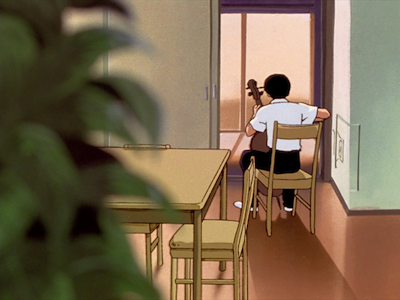
1. A vision
A vocal pop ballad in the style of the era. The chorus and reverb effect on the guitars identifies the style clearly, as well as the slight effects on the drums. The vocal is plaintive and sweet throughout. Piano and violin join throughout the piece, mimicking the melody and layering on the coloring already present. The mellow bass and electric piano comping provide a smooth bed of sound for the rest of the instrumentation.
2. Borderline Case
A percussion feature. The hand drums are a large focus of the piece, keeping a steady, repetitive groove throughout. Synthesized choral sounds are mixed with it, panning from left to right. It’s largely modal and pentatonic, dwelling on roots and fifths with some chromaticism focused on the raised fourth. The tone is moody, tribal, somewhat restless and haunting.
3. A Crystalline Night Sky
A track characterized by an arpeggiating piano line throughout. It varies between a dominant seventh chord and a minor seventh chord, making sure to end on the seventh on the highest note. The string section accompanies it with simple unison lines, as does the brass section to break up the arpeggiation and introduce a new melodic idea. The overall tone is sweet, yet with some underlying darkness.
4. Angel Attack II
A theatrical piece with high intensity. It begins with an aggressive, dissonant fanfare, but then lapses into a rhythmic dirge, led by electric guitar, bass, and piano. The brass is a highlight, showing range in the trumpets and growls in the entire section. The strings counteract by playing straight and melodic compared to the nearly out of control brass section. The track ends the same way it begins.
5. Angel Attack III
A heavy piece that integrates the orchestra as one huge, swooping mechanism. The strings take the forefront immediately, filling the sound while the brass marches forward underneath them. Later in the track, a soaring french horn takes over the melody, using the bass drum as an anchor to drive it forward. A wild, growling guitar solo completes the tension of the piece.
6. Both of you, Dance Like You Want to Win!
A waltz that plays like a piano concerto. It begins with a fierce cadenza, followed by a strict, classical dance feel, emphasized by hits in the timpani. The french horn is prominent with its glissandos and lines, and the violin fills out the piano melody. Its mood is triumphant and carefully rehearsed.
7. Waking up in the morning
A low flute feature. Another bossa styled piece, the tone quality of the flute resonates in the melody, with some padding in the strings as back up. The light hand percussion isn’t overpowering, as well as the bass, and they both provide adequate back up to the sound. The color is easy and laid back.
8. Background Music
A medium tempo rock piece. It heavily features the guitar and drums, as well as a prominent cowbell in the background. The melody lies with the trumpets, producing a very brassy sound. Strings produce padding, as well as the piano. It’s enthusiastic and could easily take the foreground despite its title.
9. A Moment When Tension Breaks
An appealing, smooth track. The acoustic guitar shines as a comping instrument in this piece, accompanied by the largely simple drum kit and the piano melody. The instrumentation is simple, keeping the colors muted and relaxed throughout the track. The use of modal interchange is very effective and tastefully done.
10. The Day Tokyo-3 Stood Still
A haunting track, dominated by a piano solo. The range is effectively used, starting high and stepping low gradually. The tensions ring out, giving the track a quiet, high tension feel. The end delivers a lonely, yet bluesy trumpet solo, playing on glissandos and octaves to achieve a mellow sound. The piano and low brass provide a deep bed for the solo.
11. Spending Time in Preparation
A drum feature, especially highlighting the timpani. This track conjures intensity even with the limited instrumentation. A drum kit and hand percussion are used to vary the feel, but the general beat stays true throughout. The piano, strings, and guitar enter briefly at key points in the track, giving it a tonal basis and more musical structure.
12. She said, 'Don't make others suffer for your personal hatred.'
A driving, forceful piece, reminiscent of old Western films. The feel comes from the rhythm in the strings, as well as the tone and style of the guitar melody. The trumpets are featured in their high range, brassy and true, and the rest of the brass section shines as well. The piano fills in the background, and the drums provide a modern rock flavor to this triumphant piece.
13. Magmadiver
A high energy, disco inspired piece. The trumpets have their say here, emphasizing both the staccatos and long tones. This is one of the few tracks that has a saxophone line, padding out the background in short bursts, as well as taking over the melody later on. The bass is also prominent with a rich tone.
14. Pleasure Principle
A deceiving title for an intense track. This track heavily features the violins, with a forceful, marcato pace. The brass is not forgotten either, with numerous slides and high points in the track. The mood is panicked and claustrophobic, rising in its frantic nature through the middle of the piece. In the latter half, it becomes more triumphant with a trumpet lead.
15. The Beast II
A slower version of previous themes, it still carries the same amount of energy and clout as the first. There is a slightly different instrumentation, adding the flute into the mix creates a different sonic color, and perhaps makes the overall mix a little lighter. The violins rise and fall to enormous heights, and even the electric guitar has its say in this track.
16. Thanatos
A pop ballad styled piece featuring the cello. The melody is plaintive at first, even when the violin takes over briefly, and very smooth. The bass is prominent throughout, especially when the groove kicks in. The flute adds color, perhaps changing the whole tone of the piece halfway through, as with the xylophone. It grows significantly brighter as it goes on, but still has an underlying melancholy.
17. Rei III
A ferocious track, mimicking the first theme in subtle ways. It is especially notable in the strings, the same heavy handed chords, although not in the same register. The track alternates between a gentle touch and one more aggressive. Slap bass and electric guitar comping is featured later in the track once the beat picks up. Its mood is very final.
18. When I Find Peace of Mind
A beautiful, mellow piece, featuring flute and guitar. The flute is very tangible, as one is able to hear the breaths and individual falls in the piece. It flows into a low violin solo, backed by bass and a light drum section, including the triangle. The chord progression is easy, yet complex, with a wandering sound. The mood evokes peace at the end of the day.
19. FLY ME TO THE MOON (TV Size Version)
A light bossa take on this jazz standard. The percussion stays upbeat, while the vocal flows and takes her own liberties through the song. The voice is mellow and serene, agreeing with the strings and piano backing her. Unlike the rest of the soundtrack, an upright bass is featured.
20. FLY ME TO THE MOON (#5 Remix)
21. FLY ME TO THE MOON (#6 Remix)
22. FLY ME TO THE MOON (Aya Bossa Techno Version)
23. FLY ME TO THE MOON (Aki Jungle Version)
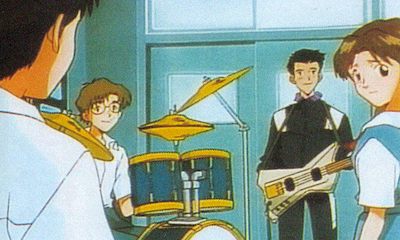
1. Happiness Is the Smell of Sin
A vocal pop track in a waltz or 12/8 form. The female vocal fits the track, and there is a heavy usage of synth paddings throughout. The bass is prominent, and the drums lay a heavy hand on the sound. A soprano sax solo is featured halfway through, and the rhythm section takes on a swing feel for its duration. The ending features the very beginning line spoken backwards, a popular technique for the era.
2. Eternal Embrace
A vocal pop ballad, starting gentle and gaining speed as it moves along. The verses stay quiet, while the chorus brings a lot of movement. The piano is heavily featured throughout the entire track. Its mood is easy and inviting, and because of the style, has a bit of a sad connotation.
3. Normal Blood
A play on a previous theme, this track is telling of impending danger and alert. The cascading violins and brass provide this color. The flute and electric guitar during the main melody are an interesting mix, but highly effective. There is also excessive activity in the drums, sounding structured but wild in their execution.
4. Harbinger of Tragedy
A play on a previous theme, another track highlighting danger. The electric guitar here is so distorted, one can hear the player shifting chords as they go along. There is an emptiness in the middle of the track, filled by diminutive brass kicks and auxiliary percussion that heighten the anxiety of the track before the guitar fills over it. The piano is featured heavily as well in its low range.
5. Childhood Memories, Shut Away
A cello solo. It is short and played with a heavy hand, conveying strong emotion. The octaves provide a spread of sound and fill the room as it solos.
6. Those women longed for the touch of others' lips, and thus invited their kisses.
A play on the jazz standard “Fly Me To The Moon”, featuring piano. The first chorus is piano only, and is played true to the standard–as a waltz. There is creative ornamentation involved without losing the melody. During the second half, a violin takes over, and the feel is changed to a gentle bossa nova. The ending is unexpected and not resolved.
7. Background Music II
A driving track in the style reminiscent of spaghetti westerns. The twang of the guitar sets it up, followed by the octave motion in the bass. The violins and a lone saxophone take the main melody, with the brass providing appropriate flourishes and kicks. The ending is particularly triumphant.
8. Background Music III
A slow, foreboding march. Low strings provide the base to this mix, topped with a brassy, Spanish inspired trumpet line over top. It particularly flourishes when it reaches the octave. Other brass join in, and the mix reaches a peak when the high strings join in on top of it, skyrocketing to the climax of the track.
9. In the Depths of Human Hearts
An eerie piece featuring piano. The track is very sparse, with only the piano in its high range and a bell accompanying it. As it moves, the low strings accompany it, as well as the timpani, for an ominous mood. Harmonics in the strings continue the mood in dissonance, somewhat emulating fear itself.
10. Hostility Restrained
A play on Rei I. The melody is largely the same, but as the track goes on, there are deep piano tremolos, helped by the strings, allowing the mood to become more ominous. It is quite foreboding with the dissonant, brooding melody.
11. Three of Me, One of Someone Else
A play on Ritsuko. The most noticeable difference is the pace and the lack of acoustic guitar. Instead, only the piano is featured, and the melody is played at a walking andante. With these changes, the tune carries a bit of a different tone, and the tonality changes are much more present.
12. Crime of Innocence
Another play on a previous theme. It begins with a piano feature, slow and steady, featuring block chords moving downward in the same voicings. Unlike the theme it’s based on, this track stays in piano the entire way through, fully compiling the moody and slightly sinister atmosphere.
13. The Sorrow of Losing the Object of One's Dependence
A sparse rendition of Fly Me To The Moon. It features the melody line only on piano, creating a lonely atmosphere. Space is maintained where there would normally be held notes. It is simple and empty.
14. Do You Love Me?
An eerie sounding track that plays on a previous theme. The chorus ahs are deep in the range, following a root and fifth pattern in the bass. The “melody” line comes in later, largely pentatonic, but adding some chromaticism to establish the feel. Despite having no rhythm section, the track has a fairly rigid feel.
15. Separation Anxiety
A percussion feature. This track features a lot of hand percussion and synthesizers, in contrast to the orchestral nature of the rest of the soundtrack. The alternating rhythms in the percussion and the bass create unique polyrhythms that keep the feel up in the air. The sitar and padding evoke the same spacey feel, with the bends in each, and with the sometimes out of time rhythms.
16. Introjection
An eerie, synth driven piece. Lots of bell oriented synths are used, as well as a vocal sound drifting over the padded chords. While the chords themselves are simple, dissonant tensions and bends are used to compound the feel. It segues into a more cohesive melody, powered by the chorus ahs as the track moves forward.
17. Depression
Another synth driven track. Fueled by an open chord progression and sweeping effects, it creates a spacious, yet unsettling environment. The occasional piano line, along with more chorus ahs, confirm the atmosphere.
18. Splitting of the Breast
A modal piece featuring chorus ahs. The beginning of the track is reminiscent of medieval music, for its singular, unison melody. The track eventually spreads out into overlapping parts, and the sound gives off a very holy, church-like sound.
19. Infantile Dependence, Adult Dependency
An ominous sounding track featuring organ. The organ arpeggios are punctuated by large bell sounds and the acoustic guitar. String lines also compliment the atmosphere. The instrumentation increases, even introducing muted brass into the track as it grows into a crescendo. It has a mild feeling of chaos before reducing itself into how it began.
20. Mother Is the First Other
A synth inspired piece, punctuated by rich, deep sounds in the bass. Chorus ahs also complement the feel, as well as another bouncing synth sound panning left and right. The chords are ambiguous, relying on fifths and fourths to keep their substance. Melody lines reinforce this unstructured tonality.
21. The Heady Feeling of Freedom
A rendition on the opening theme, featuring the mid-strings. Cellos provide a countermelody, while the acoustic guitar and keyboards establish a mellow sound bed. The mood is peaceful, with the legato melody creating a relaxing feel.
22. Good, or Don't Be
An upbeat rendition of the opening theme, featuring a piano melody. Because of the even more stripped orchestration and ornamentation of the melody, it has a brisker pace, and a very hopeful feel. The melody passes between the guitar and the piano, and pushes forward constantly.
I did not cover or post the 12 Fly Me To The Moon versions at the end of this CD.
back to top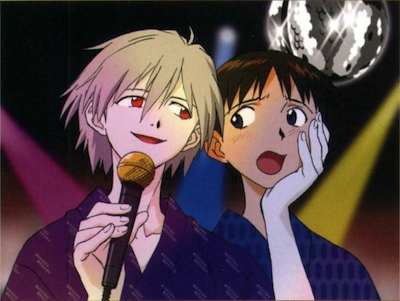
selections from "S2 Works"
1. Requiem, Sorrow (The Soft Sound of Bells?)
Another track reminiscent of a funeral drone. The centerpiece of this track is the piano, and the bell sounds, clear and ringing in contrast to the low bed of sound. The brass make an appearance, slowly growing in volume as the piece moves forward. The strings join later as well.
2. Anxiety
A driving, dissonant piece, heavily featuring the strings. It features both arco and pizzicato points in the strings, and the track suddenly picks up with lip slurs in the brass and a heavy slap bass line. An electric guitar punctuates the melody, and a rock drum kit drives things forward. The mood is unstable.
3. Determination and Anger
A steady piano driven piece. Strings join later in a sweeping, legato melody, soon accompanied by brass. At that point, the track opens up with large crescendos and hits in the timpani. Despite this, the feel is kept the same, and it soon decrescendos into the original melody.
4. Menace and Surprise
A disorienting waltz, featuring the entire orchestra. Each instrument has its different say and part, from the high brass, to the strings, to the lower horns. The consistency lies in the piano and drums, with a tambourine leading the way. In the second half, a slap bass line is added, along with a wandering, distorted guitar lead.
5. Oppression and Impatience (Serious - Done Over)
A dissonant, percussive piece. It focuses on heavily diminished chords, keeping the trumpets on top and the low piano at the bottom. There is a lot of space, and it speaks to scenes of tension. In the second half, a synth pad, guitar line, and timpani are added.
6. Liberation, Catalysis
A smooth, mellow piece, featuring the strings. A track that speaks of calmer days, the strings have a warm, full sound, as do the chords in the piano. The usage of substitute dominants create lift and movement throughout the piece. A rhythm section is added in the second half, adding more body.
7. Feeling at Peace - Hope
A beautiful rendition of “Fly Me To The Moon”, featuring a flute melody. The flute is in its very low range, and has a strong human feel–one can hear the breaths in between each phrase. The acoustic guitar compliments the earthy sound, especially as the flute goes into a tasteful solo in the second half of the track.
8. Friendship
A mellow piece, moody and lacking a rhythm section. The melody is led at first by a low trumpet, and then taken over by strings and guitar. There is excessive ornamentation on all of the instruments, and the piece seems to pull from several themes.
9. Pleasant Morning
An easy going, pop inspired piece, featuring light instrumentation. The strings are featured in many high cadenzas, and a melody line later on. The rhythm section is light and carefree, and the piano also stays in a high range. The mood is casual.
10. Relaxed and Heartwarming Day
A light hearted track, featuring a constant snare riff and flute. The jangling guitar and tambourine, combined with the steady bass, creates a childlike march sound, while the rich flute tone provides depth. A keyboard melody takes place in breaks.
11. Violent Situations With Guns
A short, aggressive track, featuring blaring horns and wild keyboards. Chords clash with the guitar lines, creating a chaotic, unsettling mood. Only at the end of the piece do things appear to come together.
12. Shock (Serious)
Another short, dissonant piece. It features heavy instrumentation, each part taking its turn while another drops out. High piano comping and strong, skyward string cadenzas increase the tension.
13. Gentle Substitute
A short, tense piece, featuring dense, dissonant strings in their highest register. The brass accompany them, and become heavier as the track comes to a close.
14. Everyday Scenes and Diversions
A driving piece, featuring small aspects of the entire orchestra. The brass carries the main kicks, with a slap bass line accompanying it. There are several horn lines, as well as the complete addition of the strings at the close.
15. Comical Scenes and Diversions
A playful blues, featuring the rhythm section most prominently. The most noticeable part of this track is that most of the horns, especially the trombones, are using plunger mutes. This creates a somewhat silly effect.
16. Peaceful
A mellow filler track, featuring the low horns and strings. This piece creates a wash of sound that’s soothing, yet ends on an unexpected progression, creating a somewhat confusing resolution.
17. Beautiful
Another filler piece that creates a wash of sound. This features more of the horn section, as well as an arpeggiating piano and harp securing the rhythmic structure. There is more movement and emotion in this track.
18. Romance
Beginning with a bell cadenza, this track is slow, sweeping, and very romantic. It heavily features the piano and strings, somewhat reminiscent on previous themes.
19. Plaintive
Another filler piece, driven by the strings and acoustic guitar. The volume swells and drawbacks emphasize the mood, as well as the general dark color of the deep strings.
20. Hastiness
A short, transitional piece, featuring many brass hits and a bed of distorted guitar. The violin tremolos add to the mood, as well as the subtle, driving percussion.
21. Fear/Panic
Another mood piece. Featuring high strings, and chromatic lines in the low brass, the latter half of the piece features high, solo piano lines to emphasize the tensions and colors.
22. [Suspense - Light]
An orchestral mood piece. The drum beat comes in and out, while a triangle and high string padding stays constant throughout. Off beat brass hits scatter throughout, as well as low strings in an ostinato. A harmon muted trumpet solos erratically in the latter half of the piece.
23. E-10 [No Menu Listing]
A driving piece, punctuated by unison hits in the orchestra. Later, the feel drops to a twelve/eight feel and into a somewhat triumphant feel, led by the trumpets. The strings provide skyward lines, the distorted guitar lends a sound bed, and the mix is sprinkled with light color, thanks to the harp cadenzas.
24. E-11 [No Menu Listing]
A march-like piece, heavily featuring the brass section. The strings enter triumphantly in a broad cadenza, accompanied by the harp. The percussion is traditional, and overall, the piece is reminiscent of a traditional march tune.
25. E-12
A track that rides with tension and heavy instrumentation. Tension builds with the brass and flute trills, and releases with the string lines. The trumpets build and fall off, and then a saxophone is featured in the main melody as the piece continues to drive.
26. E-14
Another strong piece, this time featuring a rock/disco groove. The bass line is prominent, as are the horns and strings. A distorted guitar solo is featured while the piano and strings pad out the background. Once again, there is a saxophone prominent in the back of the mix. The piece builds and falls with equal gusto, but never loses its rhythm.
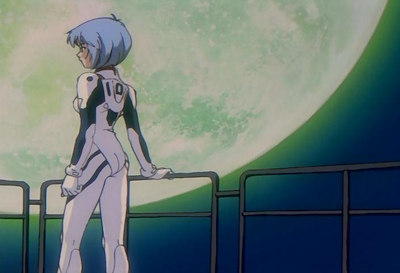
end of evangelion
1. Interference of Others (Tanin no Kansho)
An intense track, beginning with a piano ostinato in the low register. It picks up with a drum kit and more chordal structure, finding a rock feel somewhere in the tension. The groove switches in the middle of the track before going back into the original tempo.
2. The End of Midsummer
A variation on a previous piece, featuring the entire orchestra. Ear splitting strings punctuate the track, as well as a low brass melody and a driving percussion line in the toms. It pulls on many themes, this time with more power behind it because of the orchestration. The second half features a guitar solo.
3. Emergency Evacuation to Regression
A mood piece, featuring modal lines in a chorus. The sound is very tribal, with a moving upper line and a static bass chord in the bottom. It has a trance like atmosphere. In the second half, lyrics are clearer.
4. False Regeneration (Itsuwari no, Saisei)
A somewhat triumphant piece, featuring a chorus and heavy use of the orchestra. The timpani is the most prevalent, later regressing into a snare groove accented by the bass. Strings take most of the melody throughout, with the brass and chorus taking hits along the way.
6. II Air [Orchestral Suite No. 3 in D Major, BWV 1086]
A Bach orchestral suite. It largely features strings, and has a lilting feel to it. The bass holds the most tension, while the upper strings flow easily along through the melody. This track invokes a sweet mood.
7. The Flow of Emptiness
A tense piece, featuring strings and piano. The strings provide a bed, while the piano provides movement. The bass crescendos, as well as a harp cadenza, followed by a swell in all instruments before reducing to piano. The bass is in the lowest part of the piano, giving the track an ominous ring. Later in the track, the orchestra joins as the melody repeats, with more punctuation.
8. Thanatos -If I Can't Be Yours-
An R&B rendition of a previous track. The female vocal in this track is smooth and easy to sink into, even when it soars upwards. The percussion is fairly limited, and the bass is quite heavy, while the rest of the instrumentation is dreamy in comparison. There are brief changes in feel during bridge sections, and the track features solos in keyboards, bass, and strings.
9. Escape to The Beginning
This piece begins with a wash of color in the lower strings, followed by a familiar chorus of ah’s. It moves forward in a similar modal progression as previous tracks do with this motive. It seems to be accompanied by a church organ in the far back as well. Later, the strings take over the vocal chorus in a higher register, and the vocals add lyrics.
10. Honeymoon With Anxiety (Fuan to no Mitsugetsu)
A modal string piece with a strict time feel. The chords in this track are very open, even when the piano joins the fray. There are points of tension that break the track, akin to throwing stones in a pool of still water. The mood is high strung, and the piece seems to fall apart at the end.
11. Komm, süsser Tod (M-10 Director's Edit Version)
An upbeat, pop ballad. It features a small rock combo, with strings padding later on in the track. It’s easy going, invoking a pleasant mood, in somewhat contrast to the content of the lyrics. The vocal is straight forward and light, with the harmonies smooth. Near the end of the track, the strings become somewhat chaotic, and the track itself ends in a bit of a collapse.
12. Jesus bleibet meine Freude [Herz und Mund und Tat und Leben, BWV 147]
Another traditional Bach piano piece. It is flowing and gentle at some parts, heavier in others. The sound of this piano gives the impression that it was recorded in a large, empty hall. There are some minor liberties taken with the melody. It is largely a demure, soothing piece.
13. Expansion of Blockade (Heisoku no Kakudai)
A mild orchestral piece. It opens with solo violin and piano, soaring with virtuosic lines. A chorus of strings comes in later to back it up, as well as moderate percussion. The mood of this piece is calming, reminiscent of coming peace. Even as the orchestra fully expands the sound with brassy crescendos, it holds a triumphant mood. Near the end, it calls on a previous theme in various instrumental colors, darkening the sound.
14. Gap of Dream (Yume no Sukima)
A gentle piano piece. The melody lingers in the high register of the piano, with fairly open voicings in the lower register. This becomes more apparent when tension builds.
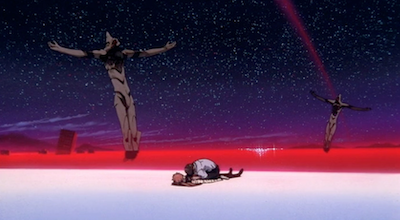
i did a few of the rebuild songs, but as i mentioned previously, i felt my mission was complete with the original release. so this will be the archive.
